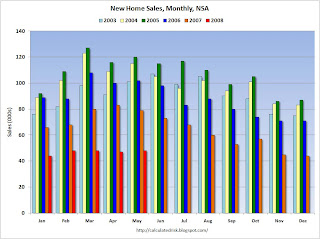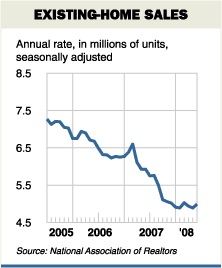Economists and others weigh in on the 2% increase in existing home sales amid declines in inventories.
· Sales have now been on net about unchanged and have shown little month-to-month volatility over the past six months, further indicating that high levels of housing affordability are stabilizing demand. This has also been seen in recent months in the new home sales figures. Inventories of unsold homes remain extremely high, but if sales continue to show stability and starts come down substantially further, a more balanced market could be achieved by the first part of next year. –Ted Wieseman, Morgan Stanley
· In what should be the best month of the traditional summer buying season the market observed a modest increase of 2.0%. The fall in prices did facilitate a decline in inventories, which provided a rare bit of sunshine in the market. However, at this juncture the conditions for a bottom to form in the housing sector are not ripe. Long-term rates have reassumed an upward trend and it is still quite difficult to obtain a non-conforming jumbo loan. While there are some good bargains for cash buyers and those that have information on prime foreclosures, the market is extremely fragile and has many more months of difficulty in front of it. –Joseph Brusuelas, Merk Investments
· Since October, existing home sales have been in a narrow range from 4.89 million to 5.06 million, suggesting that we could be near a bottom in the resales market… The months’ supply figure stood at 10.8 months in May, down marginally from 11.2 in April but still the second-highest level on record (the series began in 1999). Thus, although the resale market is showing some signs of stabilization in demand, there is still a glut of inventory that could take at least another year to work off. –Omair Sharif, RBS Greenwich Capital
· The real story in the monthly home sales data lies in the details on inventories and prices, and the bottom line to this story is that inventories remain at levels that suggest further significant declines in prices in the months ahead, particularly as the demand-side drivers of home sales continue to soften. There are some signs that sales of existing homes are forming a bottom, as suggested by the behavior of the six-month moving average of sales shown in the first chart below. –Richard F. Moody, Mission Residential
· We do think sales are approaching a bottom, as improved affordability has likely stimulated demand. In addition, an increase in foreclosure sales has likely contributed to the leveling off in sales. Foreclosures typically sell quicker than regular sales since lenders are motivated to clear the stock of foreclosures. As such, they often sell at a discount, which puts downward pressure on home prices. The existing home market is still very much out of balance, with 10.8 months of supply on the market. We expect the market to remain out of balance this year and most of next year as foreclosures add to inventory and sales remain sluggish. –Michelle Meyer, Lehman Brothers
· Existing home sales peaked during the summer of 2005 and have fallen steadily ever since. However, the pace of contraction has slowed in recent months with gains in 2 of the last 4 months. Nevertheless, the inventory of unsold homes remains very high, putting downward pressure on both new construction and particularly home prices. Home prices have been falling on a year-on-year basis for almost 2 years and, in recent months, the price declines have accelerated. Home sales will fall as long as home prices are falling, continuing to create turmoil in mortgage-related finance. –Stephen A. Wood, Insight Economics
In my earlier post, I noted the recent increase in median home prices which is positively correlated with the increase in home sales. Have we bottomed out? Personally, I think we’re there or real close. Now for the LONG climb back…
